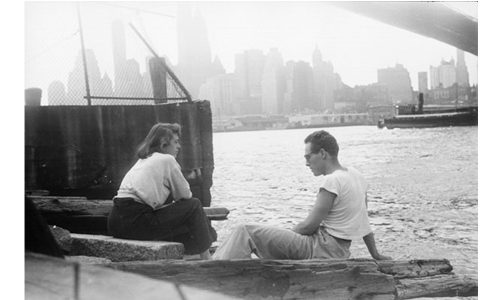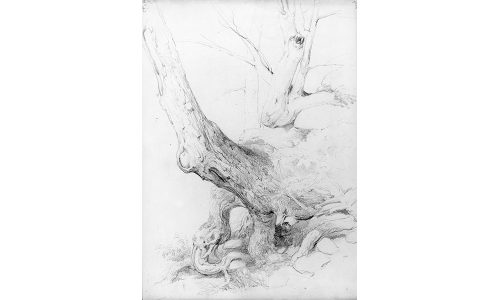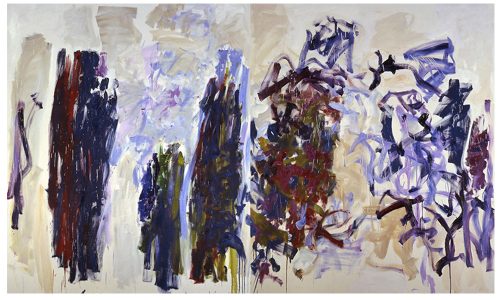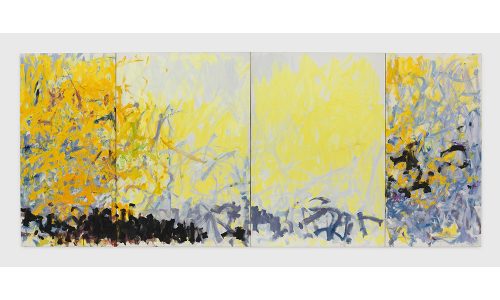When Joan Mitchell heard the phrase “New York School,” what came to her mind was space. While her downtown peers were preoccupied with inner experience, mining their selves according to the scraps of existentialist philosophy that they argued over each night in the dimly-lit booths at The Cedar Tavern, her concerns were broader and less predictable. Needless to say, she had inner experiences that were every bit as acute as theirs. What distinguished her, however, was a deep concern with how those inner experiences met and mixed with the world outside.
It is that concern with the complex and in many cases tense relationship between inside and outside, experience and world, that motivated Mitchell’s decades-long dedication to landscape. She described her interest in the genre to Irving Sandler during a visit that he made to her East Village studio in 1957: uncompelled by hermetic kinds of abstraction that strove to sever all ties from observed reality, she explained that she was “conservative” and remained committed to painting real scenes. That said, the scenes that she painted were not scenes that she had observed per se. Instead, they were scenes that she had first observed and then recollected. In Mitchell’s opinion, the passage from observation to recollection was inevitable. Even if she turned from her canvas to the open window beside her, as soon as she turned back to the canvas she would once again be “up against the wall looking for a view.” Pausing to let the implication of her example set in, standing with Sandler in the suspended light and dust, the hum of midday traffic slowly filling the room, she continued, “I carry my landscapes around with me.”
To Sandler, the painting that Mitchell was working during his visit made a similar point. Constructed from thin, interlacing brace-like strokes, it somehow seemed to span the distance between the city outside and Mitchell’s personal sensibility, giving him a distinct sensation of “girders and height” while also suggesting “varied meanings” that, while no less visceral, were much more opaque and harder to define. The title of the painting was, appropriately enough, The Bridge [Fig. 1].

Joan Mitchell, The Bridge (1957-58). Oil on canvas in two parts [116.9 x 178.5 cm]. Private Collection
Although Mitchell did not finish the painting while Sandler was there in her studio — abandoning it because it was, in her words, not “accurate” enough — she returned to it a few months later. When she finished working on it the next year, she had added a new format to her artistic practice, completing her first multi-panel painting.
Thick bands of black, blue, green, gray, and red stretched horizontally across an empty ground, the work is both a painting of a bridge and a painting of how the process of seeing can seem to change that bridge. I say “seem” because the painting leaves that long-standing question genuinely unresolved. As soon as the bands of black paint — now read as rust-touched beams set against a blue, green, and gray horizon — become available to the perceptual participation the painting allows, the composition becomes unstable. The bands-turned-beams break, and with them the joint that had fastened the two panels together, causing the composition as a whole to dissolve back into a frayed array of gestures.
Nine multi-panel paintings, all on loan from the Joan Mitchell Foundation, were recently on view at David Zwirner’s West 20th Street gallery. Alluding to the Sandler interview cited above, the spare, vibrant, and well-paced show was called “I Carry My Landscapes Around With Me,” and gave visitors a chance to consider the relationship between inside and outside, experience and world, for themselves.
The decision to concentrate on the multi-panel works was inspired. The format is in many ways dedicated to that relationship and the range of invention that it allows. When I walked from painting to painting, I was repeatedly drawn to the quarter-inch space between the panels. Each time my focus came to rest on that space it would widen and become overdetermined, opening onto the deeper distance between what is found and what is formed that Mitchell wanted to bridge. What began as a mere gap in the compositions soon became a site of synthesis and suture, a hairline fracture reminding me that those compositions were things that had been, and had to continuously be, made — stitched together under the eye.
The image of the bridge and the complex spanning of distances that it implied was one that Mitchell returned to often. When, during an interview with Dorothy Gees Seckler in 1965, the conversation turned once again to the ways in which Mitchell’s inner experiences met and mixed with the world outside, the image that occurred to Mitchell was that of a bridge. Describing the hermetic kinds of abstraction that had dominated the New York art scene when Mitchell began painting in earnest, Seckler asked her, “In those days when you began a painting, was it a matter of beginning with the medium itself or some—.” Before Seckler could finish Mitchell cut in. “Always been some sort of association,” she explained. Seckler picked up that line of questioning a moment later “We were just talking — you said there had never been any kind of painting without there being some association, something.” “Well,” Mitchell responded, “when I have it’s been pretty bad.” Learning from those earlier mistakes, she now insisted on beginning with “a sort of a feeling, it might even be a sort of feeling that I’m green or a remembered landscape or something like that. The feeling I had looking at a bridge or a river or whatever it would be.” The explanation made sense to Seckler. At the end of the interview, she summed things up: with the distance-spanning image of the bridge still fresh in her mind, she described Mitchell’s paintings as records of “what happens between something seen, and something felt.”
In the multi-panel paintings that were on view at Zwirner, that happening was on vivid and volatile display. Architectural and lyrical, they use tensile, polychrome passages to weld what is seen and what is felt together, each stroke a load-bearing strut. That said, much of their success comes from the recognition that that fusing is provisional, fragile, and temporary. Even as the paintings weld what is seen and what is felt together, they also ensure that those two poles remain separate, opening a distance that is crossed by the paintings themselves. When looking at them, your attention is split. One moment you are drawn to the scene that a given painting evokes, and the next moment you are drawn to Mitchell as she pulls back from that scene, absorbed instead by her own private impressions.
It is the absorbed Mitchell we see in a photograph taken in 1948 [Fig. 2]. Sitting on the bank of the East River across from Barney Rosset, whom she would marry the next year, helping him launch Grove Press soon after, she both does and does not belong to the scene around her. The river coursing at her feet, she recedes into a consciousness that is equally deep. And yet, here too there is the sense that the space that has opened between inside and outside, experience and world, is immediately filled by composite phenomena that blend the two, producing an alloyed reality. Although Mitchell is framed and separated from her surroundings by the wall of wood slats behind her, the contours of Manhattan re-enter through the fog and the connective beams of the Brooklyn Bridge arch overhead.

Joan Mitchell and Barney Rosset by the East River, ca. 1948. Photographer Unknown. Collection of the Joan Mitchell Foundation, New York
The photograph reproduces the productive tension between inside and outside, experience and world, that makes the multi-panel paintings so compelling. That tension can be seen in Untitled (1972) [Fig. 3]. There, passages of sky-blue, wheat-yellow, petal-lavender, and earth-ochre allude to an external scene that has been so abbreviated, so abstracted by the processes of ordering and re-ordering that are implicit in the act of perceiving as such, that the painting is on the verge of losing the association with the outside world that Mitchell found so important. The rest of the painting seems meant to shore up that association. The square slabs of paint laid flat against the canvas move the painterly idiom away from the idiosyncratic gesturalism found elsewhere, giving the composition a sense of sturdy necessity that it would otherwise lack and ensuring that the painting remains connected, however distantly, to the reality that it shapes and sculpts.

Joan Mitchell, Untitled (1972). Oil on canvas in two parts [194.9 c 228.3 cm]. © Estate of Joan Mitchell. Collection of the Joan Mitchell Foundation, New York. Courtesy of David Zwirner
The desire to maintain a connection to reality becomes most acute in the area of the painting where the idea of connection, broadly speaking, is most concrete — the space between the two panels themselves. There, in the middle of the composition, we find a pale yellow hinge — a blonde spot weld that seems to join not only one panel to the other, but also Mitchell’s composing mind to the wider world.
Needless to say, the desire to connect the composing mind to the wider world is nothing new. In many ways that desire is the defining feature of the tradition of landscape painting to which Mitchell belongs. Asher Brown Durand, a member of the Hudson River School, described that desire in a series of short essays titled “Letters on Landscape Painting” that he published in the small New York-based arts journal The Crayon in 1855. Like Mitchell, Durand insisted that the task of the landscape painter was not to “create an imaginary world” but rather to “reveal the deep meaning in the real creation around and within us.” That revelation was achieved not by simply “imitating” nature as many landscape painters supposed, but by “representing” it. “Take a tree, for instance,” Durand explained in one of the most interesting letters in the series. “[W]ith its infinity of leafage, you perceive at once that direct imitation is impossible, that is, such an imitation of its foliage as your produce of its trunk, or of the rock beneath, for to that effect each leaf must be defined as far as seen, or at least a great portion of them, and with the same proportion of them, and with the same precision with which you express the scoring of its trunk. You are then to represent this foliage in every essential characteristic, without defining the forms of individual leaves” [emphasis in original]. “Strictly speaking, beyond a few foreground objects, our Art is entirely representation.”
“Representation” as Durand understood it was a complicated two-fold process. In addition to allowing a painter to render a landscape convincingly, it also allowed that painter to charge that landscape with the expressive content that made that rendering worthwhile. That charging was the result of the process of rendering as such, and the sustained application of attention that it required. “Take pencil and paper,” Durand wrote in another letter, “and draw with scrupulous fidelity the outline of such objects as you shall select and, so far as your judgment goes, choose the most beautiful or characteristic of its kind.” Although Durand recognized that the kind of scrupulous drawing that he was recommending was “a difficult and painful task,” he insisted that the benefits more than made up for the trouble. Far from a simple act of transcription, the kind of observation that Durand was recommending allowed subjective and objective properties to merge, connecting the two in the drawing itself, which transcended its subjective and objective sources and existed as a synthetic third term. “Thus regarding the objects of your study,” he explained, having summarized the constant exercise of physical and psychological faculties that the process of “representation” required, “the intellect and feelings become elevated and purified, and in proportion as you acquire executive skill, your production will, unawares, be imbued with the undefinable quality recognized as sentiment or expression which distinguishes true landscape from the mere sensual and striking picture.”
Like Mitchell, Durand linked the expression-charging process of “representation” with the interval of space that extended between the person and the thing seen. “Space,” Durand argued, is an “intangible agent, visible, yet without that material substance which belongs to imitable objects.” Although “space” was in many ways an “absolute nothing,” Durand insisted that it had “mighty influence” serving as ”a veil or medium interposed between the eye and all visible objects.” “Space,” he explained, “above all other agencies, carries us into the picture.” By carrying us into a picture, acting as a medium connecting object and eye, space allowed both the painter and the viewer as well to exert their “imaginative faculty” on the scene represented. Indeed, Durand argued that it was only by exerting ourselves on things that we represented rather than imitated or imagined that we become aware of our imaginative faculty as such. “The imagination,” Durand explained, “like every other element of genius, can only be comprehended in its visible impress on whatever things it touches, always identical, but with comparative degrees of power, at times dimly shadowed, at others glowing with impassioned feeling.”
Durand put into practice the principles laid out in the “Letters on Landscape Painting” in a number of pencil-and-paper studies that he made while writing the series. Sketch from Nature (c. 1855) [Fig. 4], for instance, returns to the example that he used throughout the series. A patient rendering of two trees and their surrounding network of roots, the study is at the same time detailed and impressionistic, reading as a record of the imaginative faculty as it reaches out through space toward a reality that it shapes and is shaped by. In the middle of the page, a graphite gnarl swells into view. While this passage is in many ways the most objective portion of the study, capturing pocked and scored bark with painstaking precision, it is also the most subjective, capturing the area where Durand chose to concentrate his attention, allowing the rest of the scene to fade into the distance. By taking into account both these aspects of looking, the study can be said to achieve the kind of “accuracy” that Mitchell would later strive for in The Bridge.

Asher Brown Durand, Sketch from Nature (c. 1855). Graphite on gray-green wove paper [35.1 x 25.1 cm]. The Metropolitan Museum of Art, New York
Although reading Mitchell through Durand might seem counterintuitive, linking the two figures — one a Hudson River master the other an East River tenant — becomes more convincing when we consider one of the last paintings that Mitchell made. Trees (1990-91) [Fig. 5] portrays a series of stout, leafless trunks, all painted in thick strokes in a horizontal line. As was the case in Durand’s study, the action takes place in the middle distance. Where the trunks are closest to the viewer they dissolve into gestural abstraction, and where they are furthest away they disappear into hazy off-white. It is in the space between these extremes that the painting comes alive. On the left of the composition, three trunks are shown suspended between foreground and background. Like the trunks further to the right, they are painted thick gestural strokes. Here, however, those strokes do not dissolve the trunks, but are instead integrated into them. Applied in a steady, up-and-down motion, the strokes capture the layered armature of the bark and the cool wrap of the shade, providing a visceral likeness of each individual tree without giving up their association with Mitchell’s mind and hand. Like Durand’s study, the painting is “accurate” in Mitchell’s sense of the term. As she explained decades earlier in her interview with Seckler, when painting such a scene, “it wasn’t the image of the tree,” that Mitchell was interested in, “it was the moment.”

Joan Mitchell, Trees (1990-91). Oil on canvas [240 x 400 cm]. Private Collection
As mentioned above, Mitchell thrived on the tension between inside and outside, experience and world — a tension that her multi-panel paintings made specific and concrete. By spanning that distance, locating her works between something seen and something felt, she created a space where experience and world could meet.
The multi-panel painting that best presents that space is Minnesota (1980) [Fig. 6]. Twenty feet wide and eight-and-a-half feet high, it was the second largest work shown at Zwirner. An animated expanse of orange, yellow, lavender, and black, the painting records both the movement of wind across a corn field in the Midwest and the movement of Mitchell’s brush across a sheet of canvas in the studio.

Joan Mitchell, Minnesota (1980). Oil on canvas in four parts [260.4 x 620.4 cm]. © Estate of Joan Mitchell. Collection of the Joan Mitchell Foundation, New York. Courtesy of David Zwirner
However, while the painting points toward both of these references, one outward-looking, the other inward-looking, it also distinguishes between them, compelling the viewer to move from one to the other, spanning the intervening distance in the process. When looking at the painting we are encouraged to follow its lateral sweep, beginning with the left-most panel and moving slowly to the right, allowing the work to gradually open out onto an imagined field that recedes gradually from view. There, however, the sweep stops and is replaced by a dense accumulation of paint laid flat against the panel on the right. The interruption pulls us back from the scene that we had been passively surveying and returns us to Mitchell’s role as an artist and to our role as viewers in the active construction of that scene. No longer swaying stalks, the strokes are again the idiosyncratic products of the arm and wrist. Although abrupt, the interruption caused by the right-most panel does not stop the process of viewing entirely. Instead, it becomes an occasion to read the idiosyncrasy of those strokes back into the rest of the painting, building a composite phenomenon that is half-seen and half-felt as we cross and re-cross its 20-foot stretch a second and third time. Again, the multi-panel format here becomes an opportunity for both Mitchell and us to participate in the distance-spanning task of composition, concretely connecting inner experience with the world outside.
Mitchell insisted that there was some sort of association between her paintings and real scenes that she had encountered and recollected. The thrill of viewing the multi-panel works at Zwirner came from the realization that the nature of that association remained uncertain. That realization not only opens a compositional space that reaches beyond the paintings themselves, extending into the same streets that Mitchell walked while making many of the works on view, but also ensures that space, with its layered implications, remains invitingly, demandingly, open.
Viewers will be invited to enter that space when the Baltimore Museum of Art and the San Francisco Museum of Art host a major retrospective of Mitchell’s work in 2020.


